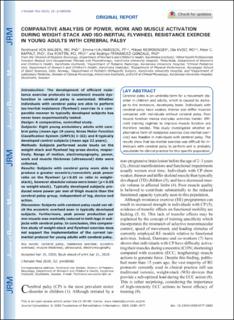Comparative analysis of power, work and muscle activation during weight-stack and iso-inertial flywheel resistance exercise in young adults with cerebral palsy
von Walden, Ferdinand; Hjalmarsson, Emma; Reimeringer, Mikael; Kvist, Ola; Raffalt, Peter Christian; Pontén, Eva; Fernandez-Gonzalo, Rodrigo
Peer reviewed, Journal article
Published version
Permanent lenke
https://hdl.handle.net/11250/2727132Utgivelsesdato
2020Metadata
Vis full innførselSamlinger
- Artikler / Articles [2096]
- Publikasjoner fra Cristin [1084]
Originalversjon
Journal of Rehabilitation Medicine. 2020, 52(5), Artikkel jrm00060. 10.2340/16501977-2682Sammendrag
Introduction: The development of efficient resistance exercise protocols to counteract muscle dysfunction in cerebral palsy is warranted. Whether individuals with cerebral palsy are able to perform iso-inertial resistance (flywheel) exercise in a comparable manner to typically developed subjects has never been experimentally tested. Design: A comparative, controlled study. Subjects: Eight young ambulatory adults with cerebral palsy (mean age 19 years; Gross Motor Function Classification System (GMFCS) I–III) and 8 typically developed control subjects (mean age 21 years). Methods: Subjects performed acute bouts on the weight-stack and flywheel leg-press device, respectively. Range of motion, electromyography, power, work and muscle thickness (ultrasound) data were collected. Results: Subjects with cerebral palsy were able to produce a greater eccentric/concentric peak power ratio on the flywheel (p < 0.05 vs ratio in weight-stack), however absolute values were lower (p < 0.05 vs weight-stack). Typically developed subjects produced more power per mm of thigh muscle than the cerebral palsy group, independent of leg, device and action. Discussion: Subjects with cerebral palsy could not elicit the eccentric overload seen in typically developed subjects. Furthermore, peak power production per mm muscle was markedly reduced in both legs in subjects with cerebral palsy. In conclusion, this comparative study of weight-stack and flywheel exercise does not support the implementation of the current iso-inertial protocol for young adults with cerebral palsy.
Beskrivelse
This is an open access article under the CC BY-NC license.
